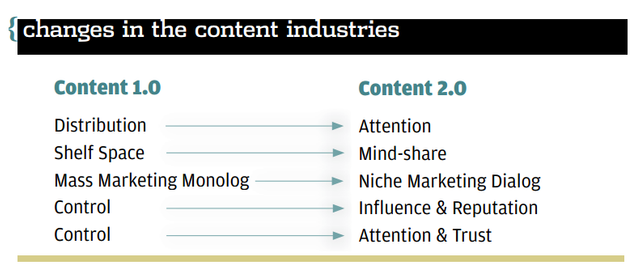The Future of Content in a Connected Economy (August 2010, Gerd Leonhard)
Found this, read it, and seemed like it hinted that a platform like Steemit could potentially be a huge part of the future: http://gerdleonhard.typepad.com/files/gerd-leonhard-inma-future-of-content-ideas-1.pdf. Finally found a piece written by a well-known futurist being very suggestive of something like Steemit since 2010. Separately developed, maybe this curation piece here could bring part vision and part implementation together, at least when it comes to the latent value of contents on this social network.
I'll leave my opinions out for now.
Note: This is not a financial advice. This is simply a curation service for something that might be of great interest to the community. Spending a lot of time reading and summarising stuff these days!
Highlights of the essay
How can we compete with free?
We have to concede that controlling distribution of digital copies simply is not working — and will not work.
Control — and the tired over-emphasis of copyright as the sole driver of value — as a central pillar of monetising content is a fundamentally flawed concept. In an open, digitally networked economy, content publishers can, and indeed must, offer their goods and services in a way that no longer centers on distribution being the key factor.
In today’s mobile and always-on world, consumers are being exponentially empowered at every turn. And, like it or not, the game has changed. Control over who defines the perceived value that will drive a purchase has shifted. Now publishers must, at all times, engage not enrage to monetise their audience. There is no other choice.
Interaction first, transaction second: the new control is trust. Therefore, I propose that our thinking — and then, our actions — must urgently head in a different direction. Here is why: transactions are always a consequence of attention and attraction, interaction, communication, engagement, and trust. It is never the other way round.
Most publishers and media companies will likely need to proceed in some sort of “permanent beta” approach. This will be a fact of life for the next five to 10 years. This is something many incumbents may want to learn from the likes of Twitter, Google, Amazon, and Facebook: it’s more important to try new concepts than to plan to perfection and never launch anything.
The bottom line is that in a connected world, you can’t just sell copies of files. You also have to sell context, community, convenience, and connectivity.
The future is in selling things around the content, not just the content itself. This, to me, is the true magic formula. And if the iPad and other tablet device can do that, even better. But to do this, the ecosystem must be opened up — not remain tightly closed.
The news and publishing industries need to embrace the fact that the users — the people formerly known as “consumers” — can no longer be reduced to being mere buyers of copies and recipients of irrelevant marketing messages. Instead, imagine a digital newspaper that provides me with great insights penned by their expert writers and editors but that also curates hundreds of other great sources that provide additional — and highly filtered — opinions and insights.
This kind of news organisation — or what we used to call “magazine” — can become a unique platform for experiences, a digital home, a valued guide. And a service I will pay for. Remember, we have always paid for packaging, for interfaces, for embodiments — not really for the words. And what’s more, advertising is likely to become content, too, because it must be meaningful, relevant, and targeted.
I am confident that selling access will be much more profitable than selling copies. Don’t worry about competing with free. Compete with value, meaning, relevance, trust, and packaging.


Don’t worry about competing with free. Compete with value, meaning, relevance, trust, and packaging. I like it;D~
Added one more important part into the highlights :)
One thing I like about Steemit is that a post is totally undefined and up to the user. Without limits is pretty good, it inspires new ways to trying things out. Can't wait when smart contracts come into play next time :)
Fascinating. And thanks for providing a nice summary.
Kevin , You always surprise me with your mind and finds .....I have so much reading material these days that I am dizzy
Lol thanks @mammasitta , just publishing my findings (like a treasure hunter, but not knowing if others like my treasure or think if they're trash hahah)
better treasure hunting you are good at than trash hoarding others are very good at :) if you know what I mean
Great piece. Bullish BLOCKCHAIN. Bullish STEEMIT. Upvoted and tweeted. Thanks for sharing. Stephen
https://twitter.com/StephenPKendal/status/824389729814777858
Not sure about other blockchains but yeah I'm personally bullish on about 20% of the coins in poloniex!.. lol thanks for the tweet @stephenkendal
No problem. Stephen
This post has been ranked within the top 25 most undervalued posts in the second half of Jan 25. We estimate that this post is undervalued by $15.88 as compared to a scenario in which every voter had an equal say.
See the full rankings and details in The Daily Tribune: Jan 25 - Part II. You can also read about some of our methodology, data analysis and technical details in our initial post.
If you are the author and would prefer not to receive these comments, simply reply "Stop" to this comment.